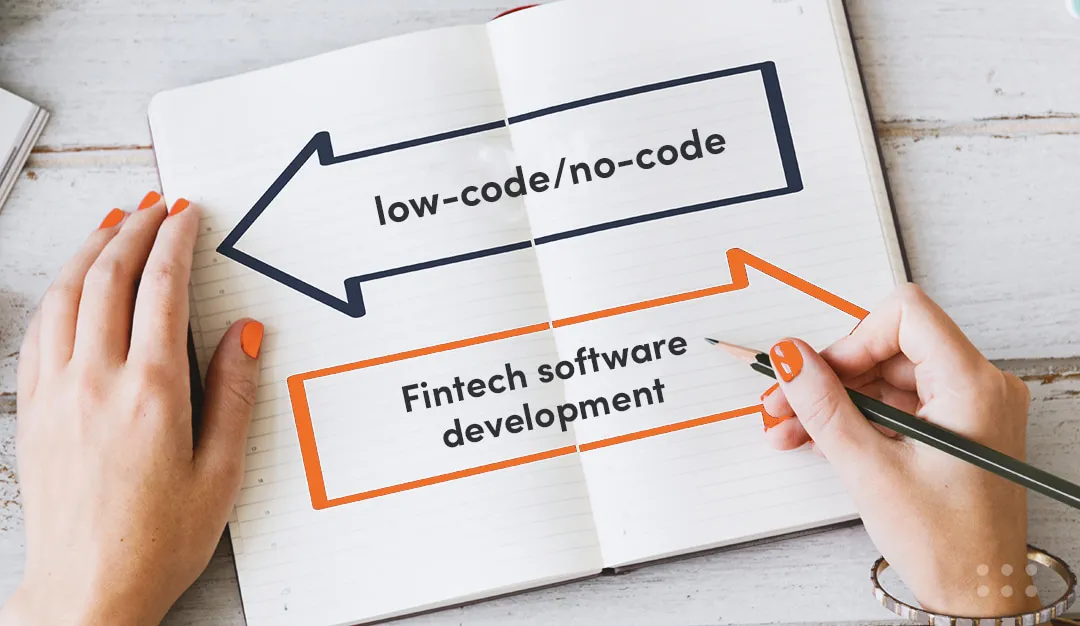The rise of FinTech over the last few years has revolutionized the tech industry. Previously, companies had only two options for developing mobile banking apps, either using an off-the-shelf solution or choosing a custom software development.
Now, there is a third and quite popular option which is low-code or no-code platforms. Acumen Research and Consulting predicts that the global low-code platform market will reach $159 billion in 2030, compared to $16 billion in 2021 (990% growth). While no-code/low-code solutions disrupt the FinTech industry, traditional custom software development is 100% here to stay.

Low-code development is a software development method involving minimum coding. FinTech software developers leverage specialized tools to build apps using simple drag-and-drop features and graphical interfaces. Examples of low-code platforms include OutSystems, Salesforce, Quickbase, Airtable, Caspio, etc.
No-code development is a method that needs no programming knowledge and experience to create the software from scratch. Again, it involves leveraging drag-and-drop capabilities and visual interfaces. Examples of no-code platforms include Glide, Appy Pie, Quickbase, Softr, Jotforms App, etc.
Custom software development involves creating software from scratch. Here, developers have no pre-made elements or drag-and-drop features. The best examples of customer software development in FinTech solutions include Stripe, PayPal, Coin-base, Apple Pay, Adyen, etc.
This article compares the low-code/no-code and custom software development approaches against several crucial criteria for developing a FinTech application. After reading this article, you will learn:
- What are the main FinTech problems and their solutions?
- Which types of applications are best suited for low-code/no-code and custom software development in FinTech?
- Pros and cons of low-code app development
- Advantages and disadvantages of custom app development
- Comparison of key features of low-code/no-code and custom software development
- Successful uses of low-code/no-code and custom app development process
- How do you choose between low-code/no-code or FinTech software development?
- When should you choose low-code/no-code?
- When should you choose custom FinTech software development?
- What is the role of AI in FinTech solutions - low-code/no-code and custom software?
- Future trends and predictions
What Are the Main FinTech Challenges and How to Address Them?
FinTech companies may face many issues, such as long-fund-raising cycles, missed targets, and increasing losses. All these issues are connected with something other than the development of the FinTech applications but with the management and strategy.
However, there are many key challenges that the FinTech industry faces every day when it comes to FinTech software development services. Some of them are as follows:

Security
In 2021 there were 1,862 financial data breaches, with average costs of $4.24 million. This is a fresh record, raising further serious doubts about cybersecurity in banking.
However, things are not as simple as they appear regarding virtual security. Because consumers' personal information and money are at risk, vulnerabilities are much more covert and may have greater consequences on users.
Solution
An organization can use the assistance of a FinTech software development company to create a highly secure app. The following features should be considered in the app to increase security:
- Two-factor authorization
- Biometric authentication
- Financial data encryption and obfuscation
- Real-time alerts and notifications
Performance
FinTech app performance depends on how smoothly it runs on different devices, how often it is updated, and what different features it offers. A FinTech app that is not fully optimized for mobile phones and lacks features like NFC chips, geo-location capabilities, and fingerprint unlocking, will be considered as a low-performing app.
Solution
A best-performing FinTech application should have the following features integrated:
- QR-code for Payment gateways
- NFC chips in shops
- Automatic scanning of a credit card number with a lens
- Two-factor authentication with a fingerprint
A high-performance app can only be achieved by integrating desired features to not clutter the app functionality or compromise user experience. A custom-app development process ensures integrating, testing, and improving such features at every step of the development cycle.
It becomes harder for developers to integrate features in a FinTech app using the low-code/no-code method as sometimes, third-party apps do not support the integration. There is another issue of mismatching codes. For example, if an app needs an auto sign-in feature and face recognition, both might not be properly integrated into one app using low-code/no-code methods.
Compliance
Numerous laws, including the GDPR, GLBA, the Wiretap Act, the Money Laundering Control Act, and many more, must be followed by FinTech software developers.
To discover which solution is better for compliance and regulations, click here: Which Fits Better Regulations and Compliance? No Code vs. Custom Software?
Solution
A firm can hire a legal consultant to guide them through all the fundamental elements and rules, if necessary. Businesses can employ consultants to do routine audits and review compliance policies and laws rather than engaging a full-time legal staff.
There aren't any reliable low-code/no-code platforms that deliver timely updates on the regulations of the country where the FinTech companies are located. A customer’s solution can do regular checks and updates of the system to meet compliance.
Cost
The cost of developing customized software might range from $40,000 to $250,000 for the design and development of the application. The price varies depending on the project's scale and the company's specific requirements. Large businesses that want highly customized software, which is challenging to develop with a low-code/no-code solution, typically find this a worthwhile alternative.
Solution
When a business uses a low-code/no-code method to develop a FinTech app, it only pays to use the specific service rather than funding its whole development.
But, when a business uses a custom method for FinTech mobile app development, they need to pay for the very scratch of code development. It includes the cost of the developer, specialized tools, and office expenses.
Which Types of Applications are Best Suited for Low-code/No-code and Custom Software Development in FinTech
Low-code/no-code has gained popularity over the last few years and has become a favorite method for developing FinTech apps, especially for internal use within companies, where customization is not critical. Custom app development is yet here to stay and has its advantages.
Different scenarios favor each method based on its requirements, such as custom software is highly favorable for FinTech apps with high user engagement.
Types of Applications Best Suited for Low-Code Development
According to Forrester, 39% of firms currently use low-code development, and 27% plan to do so in the next 12 months. Gartner also predicts that using no-code or low-code technologies for building new enterprise apps will increase from less than 25% in 2020 to 70% by 2025.
By using low-code methods, businesses can build a cross-platform mobile app, providing rich functionality for users.
Low-code development tools help businesses build web and mobile applications like the following:
- Customer engagement applications
- Employee engagement applications
- Enterprise IT business process applications
- Fusion team-developed composite applications
- Legacy modernization applications
- Operations optimization applications
- Process automation applications
Types of Applications Best Suited for No-Code Development
The no-code development approach is only suitable for
- back-office (database) applications
- simple mobile applications
- web applications
Types of Applications Best Suited for Custom Software Development
Custom software development is highly favorable for creating apps that are compliance-oriented and robust security is indeed the priority. The regulations are keep changing, so the ability to adjust in case of custom development is not limited and software houses can react faster than tool providers. They are not locked by a provider in terms of applying new regulations - which is especially important in terms of FinTech applications. Custom development is best suited for creating feature-rich apps with high flexibility.
Try our developers.
Free for 2 weeks.
No risk. Just results. Get a feel for our process, speed, and quality — work with our developers for a trial sprint and see why global companies choose Selleo.
Pros and Cons of Low-Code Application Development

The low-code method uses drag-and-drop capabilities and visual interfaces to create FinTech apps. This method comes with its advantages and disadvantages.
Pros of Low-Code Application Development
Low Risk and High Return on Investment (ROI)
Low-code platforms are built based on the highest industry standards and best security practices created by third-party apps. Developers can depend on security algorithms to strengthen app infrastructure, cross-platform, data integration, and compatibility.
Faster Time to Market
With low-code solutions, developers do not need to write custom code which helps them to get faster results.
Moreover, traditional programming languages need expertise. Companies are moving to low-code development tools to create custom applications for reporting, embedded analytics, and data collection.
Saves Money and Resources
Businesses don't have to wait for financial software developers to complete their ongoing initiatives; they can swiftly implement their ideas. By finishing tasks faster and for less money, developers help companies save their time, resources, and cash use.
Continuous Deployment
Teams can rapidly deal with potential shortcomings and unforeseen issues during deployment using a low-code app development methodology. With just one click, you can rapidly undo changes to return to a stable version and address possible problems before they become a hassle.
Seamless Integration and Lifecycle Support
Low-code development platforms support the whole project development lifecycle (SLDC). This includes pipelines for continuous integration and deployment (CI/CD). External connectors, such as those for project management and quality assurance testing tools, are also supported by low-code application builders.
Cons of Low-Code App Development
Requires a Technical Background
Despite the marketing machine's efforts to spread the illusion that low-code programming doesn't require technical knowledge, it is untrue. To make the most of low-code development platforms, the development team should include a member with a high level of technical proficiency. For instance, learning about the prerequisites and tools for low-code development needs substantial knowledge gathered over time.
Business Logic Complications
Low-code platforms use automation technologies to streamline workflows and quicken the prototype phase. However, once you get past the prototype phase, business logic becomes more advanced.
Business users become stuck at this phase and require a technical team's assistance to complete the project. Because low-code development platforms are far from flawless, it's wise not to rely only on them.
Limited Functionality
Low code development tools have limited functionality, even if they are a quick approach to creating applications. Organizations can only develop enterprise apps within the constraints of the low-code development tool.
Security Limitations
Low-code solutions do not offer the same level of security as personalized development solutions since teams have limited control over data security. Additionally, there is no knowledge of potential errors and weaknesses when you don't have access to the source code. On the other hand, in custom software, the development team is fully responsible for security measures. The team needs to build the whole solution keeping the security at the highest standards.
Advantages and Disadvantages of Custom App Development Process

With the analysis of various factors, such as the organization's size, plans for growth, and financial viability of the solution, it is also recommended to list the advantages and disadvantages of the custom development method to decide whether it is a good approach.
Advantages of Custom App Development
You Get Exactly What You Want
The design and development of personalized applications will meet the special customer needs of FinTech companies, each of which has its distinct procedures and demands. In contrast to no-code development, companies do not need to modify their existing procedures to fit the application.
Add/Remove Functions and Features as Needed
A FinTech application should have the ability to modify itself to meet changing needs as the company grows and changes. In this situation, a conventional development methodology enables businesses to add and delete features and functionalities whenever needed. By using this strategy, businesses become more agile and capable of responding to a changing market.
Robust Security
To fully protect a FinTech app from any security breach, it is essential to own the source code for the application. Unfortunately, with low-code solutions, the source code is public, which hackers can use to breach the app's security. But, in custom development, developers have sole ownership of the source code, which strengthens the security.
Service and Support You Can Rely On
When a business teams up with a reputable FinTech software development company, they can count on dependable assistance throughout the software development life cycle (SLDC). You can rely on knowledgeable and competent service and support whenever you need them during a long-term partnership with the FinTech software development company.
Scalability
Scalability is a critical factor for financial institutions. As businesses expand, the demand placed for software increases exponentially.
By working closely with the development team, businesses can ensure that the app can handle increased workloads, user traffic, and data volumes. Custom software development allows for the seamless integration of additional features and functionalities as the business requirements evolve. This scalability empowers businesses to adapt and grow without technological limitations.
Disadvantages of Custom App Development
High Costs
A personalized business application that is created from scratch is expensive. Custom development is not expensive, despite popular belief to the contrary. When companies modify low-code development to meet their needs better, the cost might be equal to or more than the cost of traditional development.
Time and Resource Intensive
It takes time and resources to write a single line of code. Before the program goes live, companies must identify business requirements, create a strategy, build the application, test it several times, and then retest it.
Comparison of Key Features of Both Solutions

When deciding between low-code vs custom app development for your business, you should consider cost, scalability, flexibility, security, and more factors. These factors help calculate the estimated risk and return on the project development.
The first step for any project development is the analysis and listing of all the requirements, strengths, and weaknesses. Comparing low-code and custom development against these requirements will help decide which is best for the organization.
Security
Custom Development
Custom apps are more secure as they can be tailored to specific security needs and include additional protocols. Since the team has written the code from scratch, they can tailor the app to new security trends and fix the potential issues.
Low-Code/No-Code
The low-code development has limited security capabilities compared to custom development. Features like face recognition, 2-factor and Biometric authentication, financial data encryption and obfuscation, army graded security protocols can not all be integrated using low-code methods.
Cost
Custom Development
According to Soltech, most customized software projects cost between $75,000 and $350,000. Of course, the ultimate cost may vary based on the project's specifications and scope, but it often becomes costly, mostly because of the project team size and duration.
Low-code
When employing low-code solutions, a company simply pays for access to the service, which is far less expensive than a custom development process. To perform the alterations, businesses occasionally want the assistance of a skilled financial software developer. Meanwhile, these costs pale compared to what would be spent on a conventional customized development job.
Time
Custom Development
Standard FinTech companies can take 4–9 months to complete before the implementation stage after going through technical analysis, prototyping, programming, and testing. Depending on the demands of the product and the size of the IT team, a project's time can vary greatly, but even in the quickest case, it always takes a few months.
Low-code
The low-code method enables significantly quicker development; general design and additional customization may take several weeks. This is made feasible by creating software using preset modules, or "blocks," rather than by writing code from the start. The reduced development time is thus one of the key advantages of no-code and low-code solutions.
Scalability
Custom Development
To enhance FinTech application features, safety, and performance, a company can easily make required changes to handle and analyze bigger volumes of data because the application was created from scratch and source code is available to the company's development team.
Low-Code/No-Code
Due to low flexibility, low-code would be challenging to maintain as the business expands and needs to grow. Since this limited scalability may badly impact the expansion of your company; therefore, personalized development is the best option in the long term.
Flexibility
Custom Development
The only constraints on manually coding for businesses are time and financial technology resources. This allows them to design any feature and achieve any integration required. Businesses also benefit from complete flexibility when picking the technological stack, tools, hosting, and APIs when creating a customized app applying the conventional method.
Low-code
Low-code solutions still have certain restrictions, even if they offer more flexibility than no-code alternatives. Additionally, if the solution provider does not support additional tools, it may be difficult to integrate apps with them.
Accessibility
Custom Development
Complete control over every area of the system is one advantage of customized app development. Your business can lower reliance on outside resources by using customized code. The finished result is your creation with full accessibility, even if external frameworks or tools are used.
Low-code
Solutions with low or no code are designed to be used by people with limited or no technical understanding. One of the most noticeable advantages of this feature is that it lessens the complexity of app development while preserving its scalability.
Performance
Custom Development
The best method for app development is to create a customized app since it makes it easier to include complicated functions. An app needs hosting services, which can only be provided by qualified programmers and developers. A custom app is fast to load and perform different functionality. The overall user experience is more convenient and comfortable.
You should engage a skilled development team if the app requires high-level features to improve app speed.
Low-code
The software cannot solve complex development issues. Thus companies should opt for no-code platforms to create an app with fewer requirements and features. This is a highly cost-effective method of app development. The drag-and-drop function requires experimentation. However, apps created using low-code methods could be better in speed. It takes them longer to load different features and perform actions due to the use of third-party apps.
Agility
Custom Development
The following advantages of using the agile methodology in customer development are possible:
- The agile approach places a strong focus on communication and cooperation. It offers a structure for routine gatherings and conversations that enable team members to exchange information, suggestions, and ideas.
- The agile approach is a framework for project management that encourages cooperation, adaptability, and continuous improvement throughout the lifespan of custom software development projects.
- The agile approach makes continuous improvement and adaptability to shifting requirements or market conditions possible. Teams can now react to new information quickly, change their development approach, and rearrange their priorities to ensure they meet their clients' expectations.
- The agile technique encourages breaking down work into smaller, more manageable pieces, such as sprints and iterations, and by regularly testing, teams may find problems and errors early in the development process.
Low-Code/No-Code
- Businesses are searching for a more agile framework that allows them to swiftly react to changing market conditions to fulfill consumer expectations and achieve a competitive edge.
- Contrarily, low code reduces the time needed for app development by utilizing prebuilt templates, boilerplate code, and several other essential 'building blocks' without manual coding.
Total Cost of Ownership
Custom Development
You can completely manage every part of the development phase when choosing custom development, allowing you to personalize the app or website to business needs. The overall cost will be favorable, and the company will own the product completely.
Low-code
Low-code might be difficult to use if the ideas that you want to execute are complex. Since the platform controls every element, including architecture, integration, compatibility, and security, total ownership of the product is not possible.
Successful uses of low code/no code and custom software - case studies
TealHQ:
Innovative recruitment platform specially designed for freelancers. Built using a potent mix of Bubble.io, Webflow, Airtable, Zapier, and HubSpot, TealHQ is not just another HRM tool - it's a revolution. And the investors see its potential too! With a whopping $11 million in funds from the likes of City Light Capital, Flybridge Capital, Oceans, Human Ventures, and a host of others, this platform is making waves in the freelancer marketplace.
Flexiple:
Learning management just got a makeover! Flexiple isn't your ordinary LMS. Built with Bubble, Webflow, Airtable, Unicorn Platform, and Zapier, it redefines what's possible in the education sector. The numbers speak for themselves: boasting an annual revenue of over $3 million as of November 2021 - it's clear that this tool is doing something right.
Dividend Finance:
Finance meets no-code in a big way with Dividend Finance. Raising an astronomical $384 million and accumulating over $1 billion in sales over the years, they've showcased what's achievable in the FinTech sector using tools like Booble.
But what's tech without seamless integration? Platforms like HubSpot let you effortlessly connect your forms with top-tier CRM systems. With Zendesk, say hello to a streamlined ticketing system ensuring top-notch customer support. And of course, Zapier, Make, and Airtable stand out as the unsung heroes - bridging data gaps and turning chaotic numbers into comprehensible insights.
The no-code movement isn't coming - it's here. And these industry leaders are just the tip of the iceberg!
How Do You Choose Between Low-code/No-code or FinTech Software Development?

After deeply analyzing the pros and cons of both methods and considering the important factors, here are some of the observations to decide whether it is good to go with a low-code/no-code or custom app development process.
Scale for the Development
You have the option to create business-grade websites or applications that are customized to business needs by using platforms for custom development. The brilliance of code allows you to develop anything and in any way possible.
Low-code platforms, however, may differ from this due to their limitations in specific cases especially if you are looking for 100% control over end result.
Budget
In traditional development, it takes professional developers months to create, implement, test, and deploy the product, which results in significant expenses. A customized solution, however, ultimately pays off despite the increased price and extended development time.
Low-code platforms, in contrast, employ visual interfaces that don't require any coding to accelerate the entire process and save expenses. This aspect for low code only holds if no plugins are involved. On a low-code platform, however, it is a completely different situation if you have many plugins loaded.
Technical Capacity
Custom app development will also be a better match for projects requiring greater proficiency in UI/UX design, advanced security, or complicated functionality - essential for launching a distinctive, ground-breaking application. However, finding a dedicated resource with the proper tech skills and capacity can be challenging and time-consuming.
On the other hand, low-code development doesn't need to discover high-tech skill sets; mid-level developers can also complete the task.
Regulatory Requirements
Due to their ease of creation and long-term viability, low-coding and no-code platforms have become popular for addressing industry requirements and security best practices.
Now that the security and seamless operation of the application is secure, businesses can concentrate on their operational goals and process optimization.
When Should You Choose Low-code/No-code?
Here are the best scenarios where choosing no-code technology is the best option:
- If the project has a constrained timeline, a small budget, and only a few programmers on staff - you can speed up the whole process with a citizen developer who is not a coder but knows how to use no-code tools.
- If the program only requires little data transfer, integration with third parties, and minor adjustments
- If the project's design and planning phases take up a substantial portion of the delivery time
Here's a list of scenarios where choosing low-code technology is the best possible solution:
- If they require the app's functionality to be more adaptable and customizable.
- If the project demands quick development with an emphasis on legal compliance (GDPR, ISO, HIPAA, etc.),
- If it's required to integrate the IoT solutions.
- If the team lacks the fundamental knowledge and specialized coding abilities that will be used in the project development
When Should You Choose Custom FinTech Software Development?
The following are the top justifications for choosing customized application development while creating FinTech software:
- When a business needs to take advantage of cutting-edge tools like AI, machine learning, big data, analytics, IoT, and blockchain.
- When a business needs to develop complete FinTech software that better complies with industry standards and legal obligations in the heavily regulated financial industry i.e. data should be stored in a country where their customers are.
- When a business increases the security of financial solutions by developing security features that have been customized to address any weaknesses or threats unique to the application.
- When strong encryption and authentication mechanisms can be implemented, security audits can be carried out regularly and automatically, and you can get more control over the system to react quickly to security concerns.
- When the app needs to be updated with the industry's most recent standards and technologies.
- When businesses are required to streamline their operations using custom development to increase productivity and save operational expenses.
- When in the fiercely competitive FinTech sector, having sole ownership of the source code or intellectual property (IP) can be a significant asset.
What Is the Role of AI in FinTech Industries - Low-code/No-code and Custom Software?
Using AI in FinTech can assist in creating quicker and more robust workflows while lowering operational expenses. AI can help execute specific operations quicker while guaranteeing fewer errors, which is ideal for the needs of FinTech companies.

AI with Low-Code/No-Code
- Improved efficiency and productivity: No-code platforms are well renowned for their ability to save time. With AI and ML, these systems can automate monotonous processes and save time for more important pursuits.
- Improved decision-making: These can give company leaders such as C-suite executives real-time information. At the same time, all confidential data will be kept secure in their hands.
- Improved user engagement: It can assist everyone in creating personalized suggestions without revealing their preferences to others. By doing so, they will retain control over their privacy.
- Reduced development time: Integrating AI and machine learning technology into no-code platforms can help expedite development and minimize time to market.
- Increased accessibility: Anyone needing AI and ML in everyday activities can utilize them without revealing personal or sensitive data. This tool is essential for primary researchers, academicians, data analysts, and others.
- Cost savings: Since the end users can build their applications, the development cost will be much lower than earlier.
AI with Custom Software Development
- By merging IT operations and application development, AI speeds up software development and enables continuous delivery of complex software. Artificial intelligence (AI)-powered tools automate software testing and quality assurance, reducing errors and saving developers' time.
- AI can also automate repetitive operations like code development, debugging, and software testing. Developers can streamline and boost productivity by utilizing AI-enabled frameworks and technologies.
- AI greatly improves code quality by finding vulnerabilities and defects early in development. AI-powered code analysis tools aid developers in identifying coding oversights, performance concerns, and security weaknesses, resulting in more safe and dependable software solutions. AI can assist with code reviews, ensuring consistency, and recommending changes throughout the codebase.
Future Trends and Predictions
According to Statista, there were over 10,000 FinTech companies in the United States alone last year and over 26,000 worldwide.
Toquio, a FinTech startup, grabbed waves in September of this year. Toquio is a low-code FinTech-as-a-service platform allowing customers to create customized digital bank-grade solutions. The company was able to obtain €20 million in investment.
According to Mendix's survey, 63% of senior finance decision-makers feel low-code has the potential to reinvent how multi-tiered financial systems are implemented. According to financial institutions experts, simplifying is critical.
The accelerating digitalization of the banking sector creates extraordinary new potential for all parties involved, including FinTech companies, banks, low-code platforms and integrators, and users. Modern FinTech incorporates technology, data, analytics, and low code to ensure the domain's continued growth.
However, there is still a big scope for custom FinTech software development services when it comes to the industry due to the following factors:
- Security
- Integration with Cloud technologies
- AI/ML integrations
- Integrations with BitCoin and Cryptocurrency
- App Personalization
- User Experience
Although the future of the FinTech sector is promising, custom software development in this sector has a more promising future.
Summary
There is an ongoing debate on low-code/no-code development vs traditional development, and it shouldn’t be considered an either/or decision. Instead, these two contrasting approaches to FinTech software development present an excellent opportunity where they can be used in tandem to drive speed and innovation.
Of course, there could be another way to consider - a hybrid of those two worlds. Those solutions can work together seamlessly for the sake of handling business use cases in the most efficient way. Depending on the use case - both solutions can be used together.
However, if you have to choose between these solutions, it is essential to take into consideration both the benefits of these solutions and your business needs for software development.





